MARIANI’S
June 22, 2008
NEWSLETTER
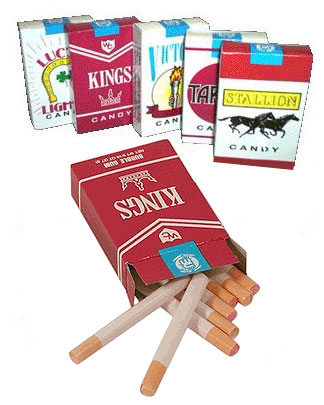
NEW! Click esquire.com
to go to my new column at Esquire Magazine.
ARCHIVE: Readers may now access
an
Archive of all past newsletters--each annotated--dating back to July,
2003, by simply clicking on www.johnmariani.com/archive
Restaurant
Index: A complete list of restaurants covered in this newsletter
since 2003. Please
click here.
SUBSCRIBE AND
UN-SUBSCRIBE: You may subscribe anyone you wish
to this newsletter--free of charge--by
clicking here.
In
This Issue
NEW YORK CORNER: Porcão Churrascaria by John Mariani
NOTES FROM THE WINE CELLAR: BAREFOOT AND BUBBLY and SIMPLY SUBLIME
by Mort Hochstein
QUICK BYTES
~~~~~~~~~
ROME
DINING
PART TWO
by
Edward Brivio
Photos by
Bobby Pirillo
Our
favorite Roman
neighborhood is the historic Campo dei Fiori, especially
at dinner time. One of the gems here is Osteria al Bric (Via
del
Pellegrino 51; 06 687 95 33). A window display of
perfectly
ripened
cheeses on straw mats invites you in. Wine-case end panels decorate the
walls: here again, you’ve stumbled upon a wine lover’s dream, run by
third- generation wine merchant, Roberto Marchetti.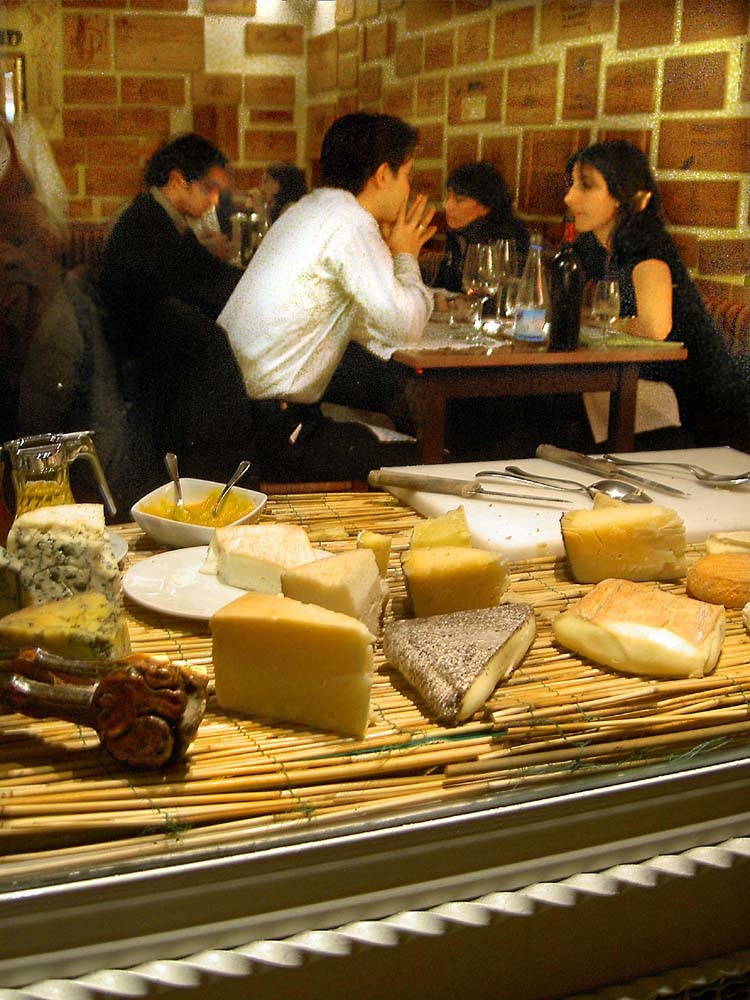
Excellent bruschetta
quickly disappeared as we looked over the menu. Mezze maniche, “half-
sleeves” (the appropriate name for pasta shaped
like truncated rigatoni), came dressed with chestnuts, guanciale, and pecorino di fossa, i.e.,
a pecorino from Sogliano sul Rubicone in
Romagna that’s been wrapped in cloth, then stashed away in caves from
mid-August until St. Catherine’s day (November 25th), giving the cheese
a sharp, intense flavor much superior to our mundane romano. The wide
swaths of pasta known as pappardelle
call for dense, earthy sauces,
especially those based on game, either lepre (hare), or, as here, cinghiale (wild boar),
a combination that’s never disappointed me here
in Italy.
Brandade de
morue seems to have emigrated quite
successfully from France to Italy, and al Bric’s brandade di baccalà
is, on its own, well worth a trip to the restaurant. The reconstituted
cod, blended with
potatoes, cream, and the right touch of garlic, was bland yet rich,
unassuming yet superb, highlighting its seamless, silken texture. I
couldn’t resist a dish listed on the menu as Sarcofage Bretone, not
only because of its connection with the movie "Babette’s Feast,"
but also because, as the menu went on to explain, it was actually cubes
of tenderloin à la Stroganoff,
in a Barolo-based brown sauce, garnished
with shards of nicely-grainy Parmigiano.
Every meal we’ve eaten here
over the years has been memorable. There are no second-class citizens
among the menu items. Creative recipes, careful preparation, and
service at once attentive and joyous seem to be the order of the day,
and we’d never think of traveling to Rome without at least one visit.
And then there’s the spectacular wine list,
and the fabulous—in the
etymological sense of something unreal, unbelievable—wine prices.
Remember, in Italy wine isn’t a vice, with its concomitant surcharge,
as it is here in the States.
I indicated to the waiter (in Italy waiters are usually their own
sommeliers) a couple of wines on the list I was familiar with, and
asked if he could recommend something out of the ordinary in the
same price range. We were rewarded with a Vigna Mortilla 2001 from
Odoardi in Calabria for 30 Euros. When was the last time $45 bought you
a bottle that knocked your socks off? It is made from a blend of
Gaglioppo
(45%), Greco Nero (15%), Magliocco Canino
(15%), and a combination of Sangiovese and Nerello Cappuccio making up
the remaining 25%. The Vigna Mortilla showcased dark fruit
flavors at once
intense yet refined, hints of spice and vanilla, and a nice tannic
finish.
Dinner
for two with cocktails,
wine and a bottle of water came
to 112 Euros.
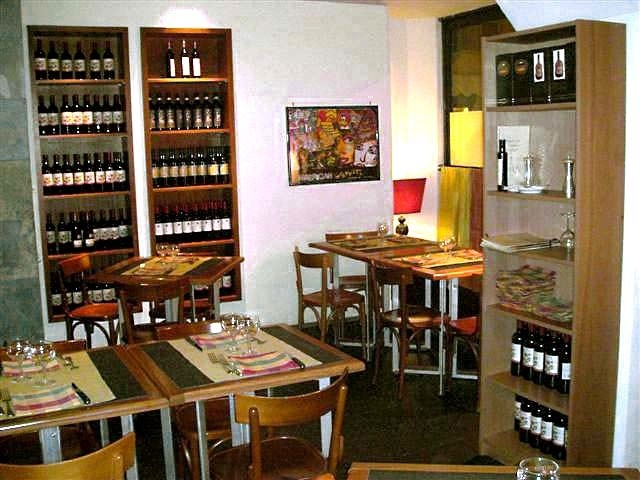 Almost
directly across Via del
Pellegrino is another must
visit: Grappolo d'oro "Zampano" (Piazza della Cancelleria 80; 06 689 70 80),
whose movie-loving owner named it after the circus
strongman in Fellini's "La Strada." Either the selection of salumi, or an aptly
named insalata di polpo--just
about as good
as octopus gets--or creamy brandade
di baccalà all did better-than-yeoman’s work as
starters. Pastas included tonnarelli
(square cut
spaghetti) cacio e pepe, and
fresh fettucine with guanciale,
carciofi,
and pecorino moliterno,
another variant of pecorino from
the town of Molino in Basilicata, that’s actually made with a small
portion of goats’ milk as well.
Almost
directly across Via del
Pellegrino is another must
visit: Grappolo d'oro "Zampano" (Piazza della Cancelleria 80; 06 689 70 80),
whose movie-loving owner named it after the circus
strongman in Fellini's "La Strada." Either the selection of salumi, or an aptly
named insalata di polpo--just
about as good
as octopus gets--or creamy brandade
di baccalà all did better-than-yeoman’s work as
starters. Pastas included tonnarelli
(square cut
spaghetti) cacio e pepe, and
fresh fettucine with guanciale,
carciofi,
and pecorino moliterno,
another variant of pecorino from
the town of Molino in Basilicata, that’s actually made with a small
portion of goats’ milk as well.
Simply heavenly maiolino, roast suckling pig as
beautiful to behold as
it was to taste, paired with broccoli Roman style--quickly
sautéed with a touch of garlic--was so outstanding
that I ordered it two nights in a row.
A 2003 Chianti classico riserva, “Il
Grigio da San Felice” (25 Euros)
worked beautifully the first night, while a Casale del Giglio, 2003
Madreselva (19.50 Euros), a Bordeaux blend of Cabernet Sauvignon,
Merlot,
and Petit Verdot from Lazio, was rich and firm enough to complement
both
the suckling pig and the robust fettucine.
The tab for two was 86 Euros the first night, and 73 Euros the second.
Our old favorite in the
neighborhood is Hostaria Farnese
(Via dei
Baullari 109), especially when the weather allows for dining out
front
at a handful of tables and watching the ebb and flow of passersby
between
Campo dei Fiori and 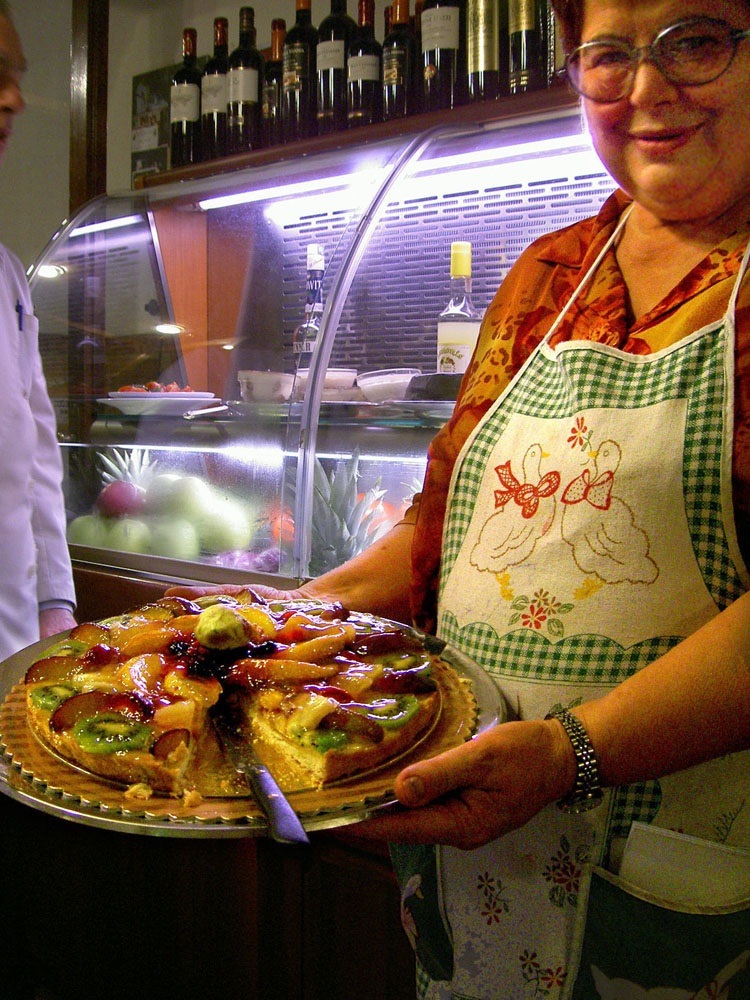 Piazza Farnese. Long an inviting, homey mom-and-pop
operation, with La Signora in the kitchen and husband Francesco making
everyone feel at home in the dining room. Mamma (right) has finally moved on to
a
well-deserved retirement. Now her son Luca has joined his father in
the
front of the house, and the welcome is as warm and friendly, the prices
as easy-to-take, and the cucina
casareccia as reliable and satisfying
as ever.
Piazza Farnese. Long an inviting, homey mom-and-pop
operation, with La Signora in the kitchen and husband Francesco making
everyone feel at home in the dining room. Mamma (right) has finally moved on to
a
well-deserved retirement. Now her son Luca has joined his father in
the
front of the house, and the welcome is as warm and friendly, the prices
as easy-to-take, and the cucina
casareccia as reliable and satisfying
as ever.
What can I say? The best saltimbocca –with fresh sage and a
light white
wine gravy—I’ve ever had; carciofi
alla giudia, aglow with olive oil
and flavored with that delicious local mint that grows only in and
around Rome; a massive osso bucco as
hearty as it was tender; trippa
alla romana –with just the right zing of vinegar--to bring an
offal-lover to his knees.
Pasta include delicious tortellini and
lasagna, and tiramisù
that
more than justifies
this simple dessert’s universal popularity. I almost forgot the equally
delicious bresaola, arugula,
and parmigiano starter.
There must be a
wine list, but we’ve never seen it, relying instead on the vino della
casa, a lovely red from the predominantly lily-white Castelli
Romani
DOC at 10 Euros the carafe.
The
meal tariff for two: 83 Euros.
 Finally,
anyone who hasn’t been to Rome in several years will be happy
to learn that not only have Termini and its immediate surroundings been
successfully cleaned up, but those very unpleasant (always keeping in
mind that actual bodily harm was never in question) though largely
inept, roving bands of larcenous gypsy children, ages 8 to 14, that
made certain neighborhoods and certain sights uncomfortable to visit,
have somehow been gotten rid of.
Finally,
anyone who hasn’t been to Rome in several years will be happy
to learn that not only have Termini and its immediate surroundings been
successfully cleaned up, but those very unpleasant (always keeping in
mind that actual bodily harm was never in question) though largely
inept, roving bands of larcenous gypsy children, ages 8 to 14, that
made certain neighborhoods and certain sights uncomfortable to visit,
have somehow been gotten rid of.
They will also find that traffic noise
on even the busiest of Rome’s Corsi or Vie is nowhere near as
god-awful as it once was, now that those swarms of two-stroke,
seemingly muffler-free Vespas (“wasps”, indeed, very loud,
ubiquitous ones) have been outlawed. There are still plenty of Vespas,
as well as other brands of mopeds—they are, after all, the best
motorized way to get around the city— but all would now appear to have
fully functioning mufflers.
"Roman Holiday" (1953)
TO READ PART ONE OF THIS
ARTICLE, CLICK.
NEW YORK CORNER
by John Mariani
Porcão NYC
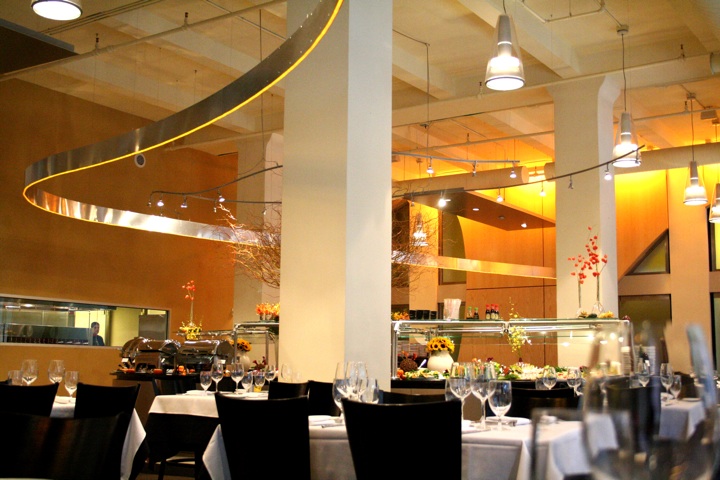
360 Park Avenue South
(at 26th Street)
212-252 7080
www.porcaous.com
It's been a good idea since 1975, when the first Porcão opened in Rio de Janeiro, then expanded to other Brazilian cities, then to Miami and New York. And it's a very simple one: You get to stuff yourself at a set price--$35.90--on all the salads and appetizers you can get onto successive plates, then, when you've polished that off, waiters bring long skewers of meats to your table and slice off however much you desire, again and again and again, until you turn over a green disc to reveal its red underside--STOP! It's a helluva lot of fun, a real gorge on the Gargantua-Pantagruel scale. It may well be a "guy thing," but plenty of women also love the concept, and they keep up--caipirinha for caipirinha.
The first time I went to a churrascaria was in Rio, and I thought the idea would catch on like wildfire in the meat-loving U.S.A. And it did, with other non-Porcão churrascarias popping up around the country. Porcão's is certainly the most identifiable and familiar, for they do it all with real dash and splash, and the décor in the NYC operation has a shadowy glamor, with dark recesses within a vast, pillared space, huge windows on two sides, a lively bar, and lights focused on the salad and appetizer bar. There are tablecloths and thin wineglasses. Make it a table for two or twenty-- they have plenty of room--yet (I was there on a slow night) the noise wasn't deafening, and the Brazilian music was a refreshing change from the Techno-crap played elsewhere in such big venues.
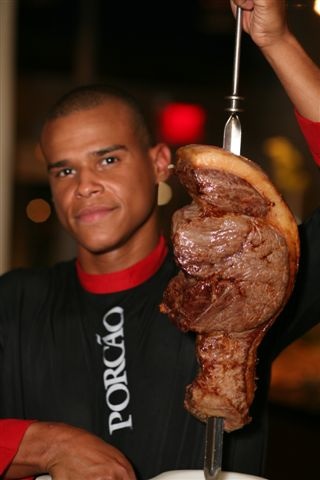 And
so we began. You don't want to seem overly anxious to hit the app
bar, so
you order a cocktail--the caipirinhas are made fresh in front of you by
a waiter--and fiddle with the green-red disc and make small talk,
and
then, when you can't stand the pangs of hunger any longer, you hit the
bar, amazed at the range of offerings--40 of them--from salad greens
and mozzarella balls to shrimp and beans and sushi and pasta and on and
on. You load up your plate foolishly because you can't help
yourself, even though you know the main event is coming up. So
you nosh on the starters, eating way too much (management is well aware
that
you will, so you won't be eating nearly as much meat as you thought),
and then take a deep breath and summon the skewer bearers.
Sizzling cuts of beef, lamb, pork, sausage, turkey, chicken thighs,
filet mignon wrapped in bacon, and other meats, all perfectly
seasoned, are paraded by you one at a time, and they start to
slice as you help pull the meat off with little tongs.
And
so we began. You don't want to seem overly anxious to hit the app
bar, so
you order a cocktail--the caipirinhas are made fresh in front of you by
a waiter--and fiddle with the green-red disc and make small talk,
and
then, when you can't stand the pangs of hunger any longer, you hit the
bar, amazed at the range of offerings--40 of them--from salad greens
and mozzarella balls to shrimp and beans and sushi and pasta and on and
on. You load up your plate foolishly because you can't help
yourself, even though you know the main event is coming up. So
you nosh on the starters, eating way too much (management is well aware
that
you will, so you won't be eating nearly as much meat as you thought),
and then take a deep breath and summon the skewer bearers.
Sizzling cuts of beef, lamb, pork, sausage, turkey, chicken thighs,
filet mignon wrapped in bacon, and other meats, all perfectly
seasoned, are paraded by you one at a time, and they start to
slice as you help pull the meat off with little tongs.True, it's a show, and, true, the whole thing is a formula. But the meats are of very, very high quality, and the way they are cooked, in such volume, throughout the night, means they get to you in impeccable condition, even to the desired temperature or color you prefer. You go on and on, half thinking you don't want to eat any more, half believing you'll be thought a wimp if you turn over your disc.
And if they can stand the parade of meat, you can even bring your vegan friends. And your wineloving friends will be delighted with the selection from Spain, Portugal, and South America.
So you get up, settle your center of gravity, and pat your stomach. To say no one leaves hungry is to state the obvious. To promise everyone will have a good time is the key to understanding the flamboyance and jollity of Porcão.
Porcão is open daily for lunch and dinner. Dinner is set at $35.90. Business lunch, $22.90.
NOTES FROM THE WINE CELLAR
BAREFOOT AND BUBBLY
and SIMPLY SUBLIME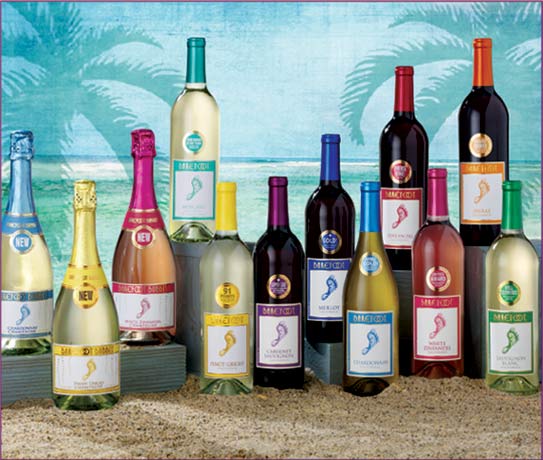
by Mort Hochstein
Really: A
few weeks back, Barefoot Wine,
a group whose
name tells all, sent me a batch of bubbly, half a dozen bottles of
fizzy types. The Barefoot people, non-elitist, always casual and
disdainful of accepted doctrine, call their line "Champagne," a
designation which does not bring joy to the French who have lobbied and
legislated to
keep that term all their own, even clamping down on Gallic winemakers
operating outside of the small Champagne district.
Call them sparklers or call them Champagne,
Barefoot’s bubblies, like all their wines, make no pretensions, other
than providing inexpensive, easy drinking. Chardonnay, Pinot
Grigio Sauvignon Blanc, Muscato, even a sparkling White Zinfandel
bubbly, they are just plain delightful, any-occasion
choices.
Unlike French Champagne and unlike many
other
prestigious non-Champagne
labels (e.g., Roederer, Iron
Horse and Domaine
Chandon in the United States) Barefoot Wines are made in huge batches,
with none
of the delicate and costly care involved in fine Champagne.
At about a ten dollar retail suggested price, often discounted
down to $8, who can quibble while enjoying light,
airy, fruity fizzies that go with just about anything? If you’re one of
those who reserve sparklers for special occasions, forget about it: you
can enjoy these anytime and the price is certainly right.
Proceeding
from simple to sublime, I went soon
afterwards to the opposite extreme as I helped celebrate the
200th
anniversary of one of the great French houses, Champagne
Henriot. At The Modern, the posh restaurant in the Museum
of Modern Art in Manhattan, Stanislaus and Joseph Henriot, members of
the founding family, brought out a handful of treasures from their
ancient cellars, 60 feet below the cobblestone streets of Reims.
Henriot is one of the few remaining family-owned major producers
and father and son promised us they would resist the lures of the
conglomerates which dominate the Champagne trade.
Our tasting, with many of the wines arriving
in oversized bottles, primarily magnums, one from a
jeroboam, the equivalent of four normal bottles, took us on a
great ride, from 1959 through 1996. Evident through the stretch
was a certain austerity, almost an aversion to the fruity, lush, easily
approachable style so popular today. It’s as if the earliest Henriot
was still around, commanding his descendants to make a serious,
uncompromising sparkler and damming today’s market-driven
fashions.
The Henriots are wines to be studied as much as
enjoyed. The wines we sampled were a blend of Chardonnay
and Pinot Noir with ratios differing according to the harvest.
The ’96 Brut Millesime, 53% Chardonnay, 47% Pinot Noir, was
surprisingly fresh, with mineral and spice tones, and an attack that
lingered long after the glass was set down. In contrast the 1990,
poured
from a jeroboam, was more complex, the vanilla of wood barrel aging
showing up front and yielding to scents of fig and dried fruits on the
nose, fresh and balanced on the palate, with a bundle of scents
lingering after drinking.
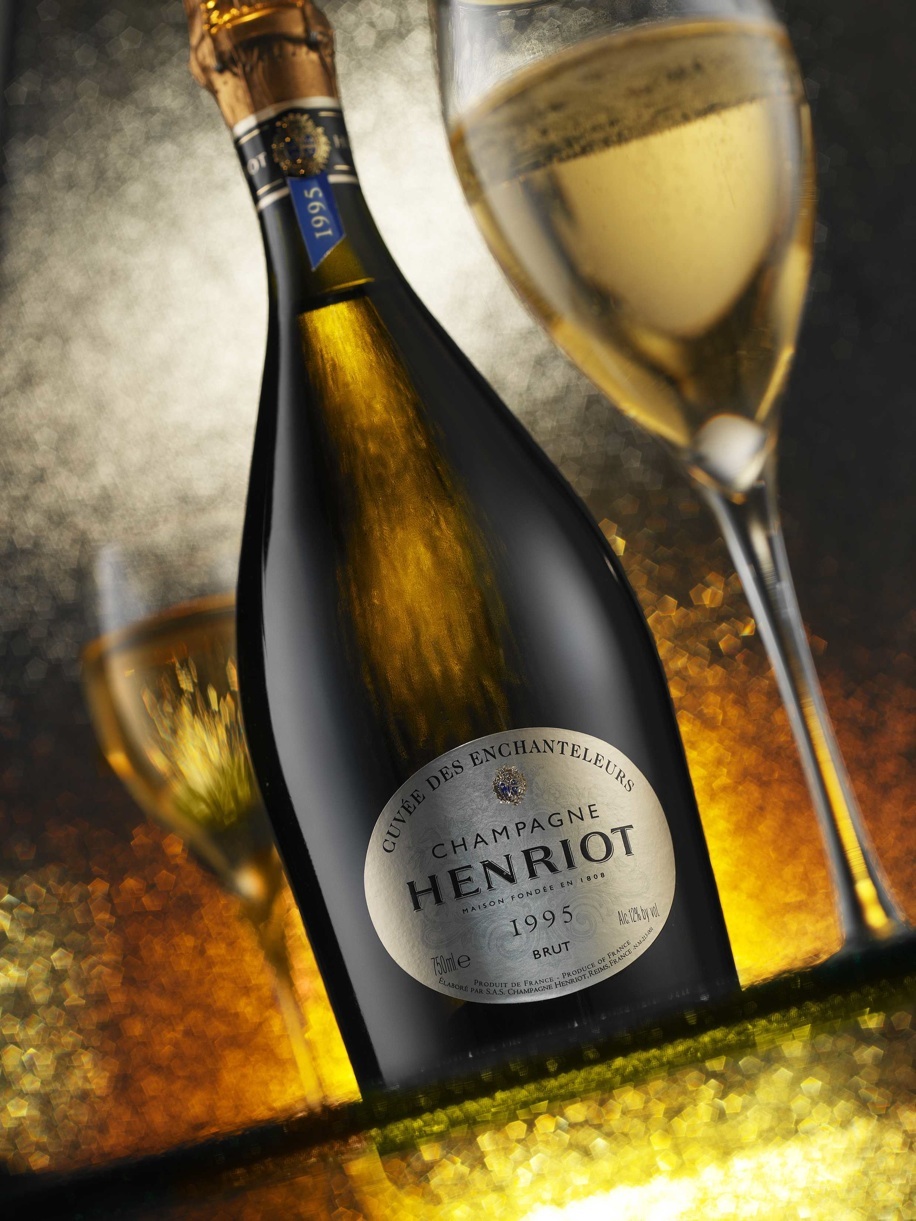 We tasted four Cuvées des
Enchanteleurs,
and those of us who thought Enchanteleurs had a
romantic derivation found we were wrong: Joseph Henriot explained
that chantel referred
to a barrel stacking arrangement
in Champagne cellars and the chanteleurs, the
crew that stacked the barrels were, in days gone by, permitted
to assemble their own blend. Eventually, Henriot execs realized that
the crew was making the best possible wine and appropriated
the name and style for the leading blend of the house.
We tasted four Cuvées des
Enchanteleurs,
and those of us who thought Enchanteleurs had a
romantic derivation found we were wrong: Joseph Henriot explained
that chantel referred
to a barrel stacking arrangement
in Champagne cellars and the chanteleurs, the
crew that stacked the barrels were, in days gone by, permitted
to assemble their own blend. Eventually, Henriot execs realized that
the crew was making the best possible wine and appropriated
the name and style for the leading blend of the house.
Joseph Henriot, now the senior member of the
family, made his first Enchanteleurs in 1959, and we tasted it
from magnum. It was disgorged fairly recently and came across very
clean, refreshing and surprisingly young and intense. The bubbles held
well, and the wine was appealing on the palate, with a long
aftertaste. It’s too bad there isn’t more of the ’59 outside of
the Henriot library.
The ’64 and the ’95 Enchanteleurs (a mere child of
a wine), demonstrated the same strength on the palate and
good fruit, particularly the ‘95. The ’64 showed more of a
yeasty, brioche nose; both were rich and golden in color. Of the
wines we tried, the ’76 Enchanteleur was the most
problematic, a bit ascetic, smoky and slow to
unveil the floral attributes of its cellar mates. All, however,
showed the strength and persistence characteristic of the line. These
are wines to be taken seriously, almost with a scholarly
approach, sipped, studied and discussed.
From the Enchanteleur
line, only the ’95 is available, at 190.
The ’96 and ’98 Brut Millesime sell at $84 and
the 2002 Brut Rosé Millesime goes for $91. Also available
are a trio of non-vintage bottlings: Brut Souverain, $50;
Blanc Souverain Pur Chardonnay, $60,and Brut Rosé, $69.
Henriot
wines approach maturity slowly in those deep cellars. The Brut
Souverain rests for two to three years before being released, the
Brut Millesime for five to eight years and the Enchanteleurs for eight
to 13 years before being disgorged to meet the demands of
the market.
~~~~~~~~~~~~~~~~~~~~~~~~~~~~~~~~~~
WE'LL
DRINK TO THAT! 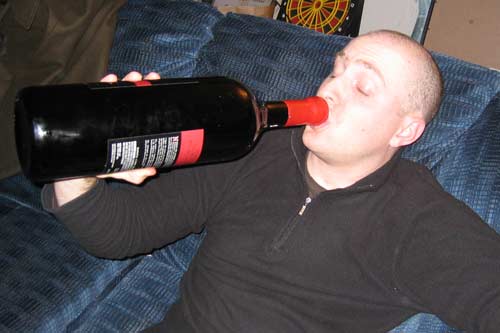
A research team led by Tomas A. Prolla
and Richard Weindruch of the University of Wisconsin reported in the
journal PLoS One the oxidant
resveratrol abundant in red wine may be effective in causing people to
live longer lives. In earlier studies of mice on treadmills, the
animals were large amounts of resveratrol that would have
equaled 100 bottles of red wine a day, but the new report used a
dose on mice equivalent to just 35 bottles a day. According to Dr.
Weindruch "a mere four, five-ounce glasses of wine starts getting
close to the amount of resveratrol they found effective."

PLEASE JUST LEAVE!
QUICK BYTES
* In Paris, Hôtel
de Crillon has re-opened the Patio with a host of seasonal
cocktails and an ice cream trolley available throughout the day. Chef
Jean-Francois Piège has expanded C’est Chic (55 euros), Le
Pic-nic! menu, with a Chic & Choc (35 euros) menu of and a
third for children, Le Petit Pic-nic (25 €). Visit www.crillon.com.
* On June 23 at Daniel
in NYC a Taittinger wine dinner will be held with sommelier Philippe
Marchal and master sommelier Olivier Masmondet. $395 pp. Call
212-933-5262. Visit www.danielnyc.com.
* On June 26 Cuvaison
Winery is hosting a wine dinner at The Sea Grill in NYC
presented by Cuvaison Estate Wines President, Jay
Schuppert. $135 pp. Call 212-584-4323.
* From July 4-6 in Jamaica, the Pepsi Portland Jerk Festival at
Folly Estate, Boston Beach, and Frenchman’s Cove in the resort area of
Port Antonio, kicks off with the official opening and Children’s Fun
Day at the Boston Playing Field and all-inclusive beach party,
with cuisine from Portland’s leading chefs and music by
Renaissance Disco. The highlight will be the “Big Show” on Sundayat the
Folly Mansion ruins with more than 25 stalls showcasing the best jerked
foods available on the island. Call 1-800-JAMAICA (1-800-526-2422).
Visit www.visitjamaica.com
* Beau-Rivage
Palace in Lausanne has created a special 3-night Summer Spa
Package, available through Sept. 30, priced from CHF 750 (approximately
USD 720), including VAT and service charges, the special includes: 3
nights accommodations in a garden-view room; buffet breakfast in
the Salon Grammont or room service; Exclusive Jubilee treatment at the
Cinq Mondes Spa (per person); Lunch at the spa's restaurant; 4-course
dinner at La Rotonde; Free access to the Cinq Mondes Spa and the tennis
courts, and more. Call 011-41 21 613 3333; or through The Leading
Hotels of the World at: 1-800-223-6800; visit: www.brp.ch.
* From July 10-13 The
American Institute of Wine and Foo
(AIWF) National Leaders Symposium will bring together this
organization’s principals and members in Monterey, CA, for a
behind-the-scenes look at the region’s agricultural industry, fishing
and wine industries, with custom-created insider visits, incl. a tour
of the Salinas Valley, Monterey Peninsula wine tour, the Monterey
Aquarium and Hopkins Marine Research Laboratory, as well as gourmet
food and wine tasting excursions. Participants can choose
from a series of small-group Dine Around Dinners in Monterey, Carmel,
and Pebble Beach, capped by a gala “Passport Around the World”
soirée in the private, members-only Beach & Tennis Club
dining room at Pebble Beach. Visit www.aiwf.org.
* From July 12-30 in Los Cabos, Mexico, Pueblo Bonito Oceanfront Resorts & Spas
Chef Antonio de Livier presents PacifiCooks, with some of Latin
America's most popular Master Chefs, as well as culinary artists from
Mexico. Chefs incl: Enrique Olvera , Restaurante Pujol; Guillermo
Gonzalez Beristain, Grupo
Pangea; Benito Molina
. La Manzanilla, Silvestre, and Muelle Tres; Paulina
Abascal, Pastry Shops and host of the Pasterleria.mx TV show;
Federico Lopez, Ambrosia Culinary Academy; Ricardo
Muñoz Zurita, Café Azul y Oro. visit www.pueblobonito.com
or call (800) 990-8250.
* On July 13 in East Hampton,
NY, in celebration of Nick &
Tony’s 20th anniversary, the
2008 Great Chefs Gala Dinner Dance will be held with 12 of NYC’s and
East End chefs, hosted by Drew Nieporent, Toni Ross, and Nick &
Toni's as a fundraiser for Bridgehampton's Hayground School. Chefs
incl. Claudia Fleming of The North Fork Table & Inn, Alfred Portale
of Gotham Bar & Grill, Eric Ripert of Le Bernardin, Jonathan Waxman
of Barbuto, et al. For tickets and sponsorship info, call 631-327-0573;
visit www.nickandtonis.com
.
* On July 14 New Rivers
in Providence will hold the 3rd Annual Rhode Island Chef Smackdown to
benefit the AIWF Rhode Island Patricia Tillinghast Memorial Scholarship
at Johnson & Wales University and Days of Taste. Five Chefs from
Providence and Five Chefs from Newport will duke it out culinary style.
$125 pp. Call 401-683-2490.
* From July 16 -20 The New Orleans Culinary and Cultural Preservation Society, will hold its annual Tales of the Cocktail, a culinary and cocktail festival on July 16-20, 2008, features award-winning mixologists, authors, bartenders, chefs and designers in the New Orleans French Quarter at dinner-pairings, cocktail demos and tastings, seminars, mixing competitions, design expos, book-signings and much more. Visit www.TalesoftheCocktail.com.
* From July 17-19 in Oakville, CA, the Robert Mondavi Winery’s TASTE3 will
bring more than 300 guests that incl. Cary Fowler, Executive Director
of the Global Crop Diversity Trust; Dan Barber, chef/owner, Blue Hill
& Blue Hill at Stone Barns; Tea expert and vermicologist David Lee
Hoffman, et al. Private winery dinners at Etude, Gargiulo, Hall Wines,
Mumm, Quintessa and Rubicon Estate, and more. Conference registration
is open at www.taste3.com or call 707-967-3997. A limited number
of fellowships are available; details are at www.taste3.com.
* On July 17 in Chicago, Cafe
Matou will host its summer
Bière Night. Chef/Owner Charlie Socher and Wine Director James
Rahn will present a Provencal-style summer 5-course meal featuring
locally-grown produce and summer micro brews. $67 pp. Call
773-384-8911; www.cafematou.com.
Everett Potter's Travel Report:

~~~~~~~~~~~~~~~~~~~~~~~~~~~~~~~~~~~~~~~~~~~~~~~~~~~~~~~~~~~~~~~~~~~~~~~~~~
Eating Las Vegas is the new on-line site for Virtual Gourmet contrinbutor John A. Curtas., who since 1995 has been commenting on the Las Vegas food scene and reviewing restaurants for Nevada Public Radio. He is also the restaurant critic for KLAS TV, Channel 8 in Las Vegas, and his past reviews can be accessed at KNPR.org. Click on the logo below to go directly to his site.
~~~~~~~~~~~~~~~~~~~~~~~~~~~~~~~~~~~~~~~~~~~~~~~~~~~~~~~~~~~~~~~~~~~~~~~~~~~
Tennis Resorts Online: A Critical Guide to the World's Best Tennis Resorts and Tennis Camps, published by ROGER COX, who has spent more than two decades writing about tennis travel, including a 17-year stretch for Tennis magazine. He has also written for Arthur Frommer's Budget Travel, New York Magazine, Travel & Leisure, Esquire, Money, USTA Magazine, Men's Journal, and The Robb Report. He has authored two books-The World's Best Tennis Vacations (Stephen Greene Press/Viking Penguin, 1990) and The Best Places to Stay in the Rockies (Houghton Mifflin, 1992 & 1994), and the Melbourne (Australia) chapter to the Wall Street Journal Business Guide to Cities of the Pacific Rim (Fodor's Travel Guides, 1991). THIS WEEK: A Report on The Four Seasons Jackson Hole. Click on the logo below to go to the site.

~~~~~~~~~~~~~~~~~~~~~~~~~~~~~~~~~~~~~~~~~~~~~~~~~~~~~~~~~~~~~~~~~~~~~~~~~
MARIANI'S VIRTUAL GOURMET NEWSLETTER is published weekly. Editor/Publisher: John Mariani.
Contributing Writers: Robert Mariani,
Naomi
Kooker, Suzanne Wright, John A. Curtas, Edward Brivio, Mort
Hochstein, Suzanne Wright. Contributing
Photographers: Galina Stepanoff-Dargery, Bobby Pirillo. Technical
Advisor: Gerry McLoughlin.
Any of John Mariani's books below
may be ordered from amazon.com by clicking on the cover image.
 My
newest book, written with my brother Robert Mariani, is a memoir of our
years growing up in the My
newest book, written with my brother Robert Mariani, is a memoir of our
years growing up in the For those of you who don't think of the Robert and I think you'll enjoy this very personal look at our --John Mariani |
 |
 |
 |
 |
 |
 |
© copyright John Mariani 2008
